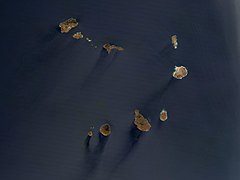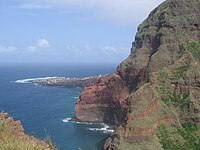Macaronesian
Macaronesia is the collective name for five archipelagos in the North Atlantic, more or less close to the African continent: the Azores, the Canary Islands, Cape Verde, Madeira and the Salvajes Islands.
The term comes from the Greek μακάρων νησοι or μακάρων νήσοι (blessed islands), lucky islands, islands of the Blessed or the abode of deceased heroes according to Greek mythology, in the extreme West.
The islands of Macaronesia have many natural characteristics (botanical, zoological, geological and climatological) in common: they are, for example, of volcanic origin and host a particularly rich and diverse flora, with abundant endemism.
To these islands is added the so-called African Macaronesian enclave, an area of the African coast located approximately between the Canary Islands and Cape Verde (that is, between the coast of Western Sahara and the Gambia River, approximately), which shares some of the endemic species of the Macaronesian archipelagos.
Geology
All the islands of Macaronesia have a volcanic origin, although the nature of this volcanism is only clear in the case of the Azores, which rise directly above the mid-Atlantic ridge. Regarding the rest of the archipelagos, there is speculation about the existence of several hot spots in the Atlantic Ocean. In addition, in some islands located on the continental-oceanic transition crust, such as Lanzarote and Fuerteventura, the rise of pyroclastic material has been able to transport sedimentary material from the continental edge to the surface.
Paleomacaronesian
The oldest rocks of present-day Macaronesia are found in Salvaje Grande, with an age of 27 million years, suggesting that this was the first island of the group. However, thanks to modern underwater mapping systems, seamounts and mountain ranges have been discovered that present evidence of having emerged above sea level in the past. These seamounts originated in the Paleogene (64-25 Ma BP) due to the activity of the same hot spots that would later originate the islands we know today in Madeira and the Canary Islands. A third hot spot would have formed the Sahara archipelago, between the Canary Islands and Cape Verde, currently submerged. Finally, to the south of the Azores is another archipelago formed solely by seamounts called Gran Meteor. The oldest of these seamounts, Omonde (Madeira volcanic province) and Lars (Canary Islands volcanic province), are at least 70 million years old, having emerged during the Cretaceous. This practically triples the estimated age of the group of islands that is Macaronesia.
Climate
The Macaronesian climate is determined by the prevailing winds, the trade winds and occasionally by the sirocco, ocean currents (Canary current) and its geographical latitude. It ranges from the oceanic, temperate and humid climate of the Azores and Madeira, to the mild tropical climate with very little and irregular rainfall in Cape Verde.
Flora
The islands present unique ecosystems made up of endemic fauna and flora. Neither was geologically part of the African continent, so biodiversity reached the islands via air and sea.
The important enclaves of laurel forest stand out, a type of relict forest from the tertiary era that covers areas of Madeira, the Azores and the Canary Islands and are redoubts of those that existed in the Mediterranean area before the ice ages. The felling of forests to obtain wood and arable land has produced a significant setback of the native vegetation, with the laurisilva being reduced to small redoubts. Something similar to what happens with the dragon tree, which appears in the Canary Islands, Cape Verde and Morocco, and with a good part of the biota of the islands, which is in serious danger of extinction.
The flora varies depending on the height and its exposure or not to the humid trade winds, coming from the northeast. Thus, in the Canary Islands, for example, several clearly differentiated bioclimatic floors can be distinguished:
- Ground zone. It is divided in turn into a coastal belt dominated by the sweet tabaiba, awning or tarajal up to 100 m and, above it, the xerophic communities, formed by cardones, classrooms, verodes, bejeques, dredges and palm trees.
- Laurisilva Forest. It appears in those islands with high enough mountains to generate the sea of clouds, usually on the northern slopes between 600 and 1500 m. Lauraceae are the predominant plants, accompanied by ferns, sages and filmmakers, as well as brezos and fayas.
- Pain. The canary pine is the main species and may be present until 1900 m of altitude. Although it has little sotobosque, there are also codes, jars or tomillos.
- High mountain. The peak areas of the islands with the largest mountains have a bushy vegetation formed by numerous endemisms, among which are leguminous, tajinaste or violet.
Demographics
Until the 15th century the only inhabited Macaronesian archipelago was the Canary Islands, which was colonized in ancient times by North African peoples. Subsequently, all the archipelagos have received strong migratory currents from Europe and Africa. At present, many of these island territories support a high or very high population.
Islands
- Notes
1 Date of rediscovery in the case of the Canary Islands, known in antiquity.[citation required]
Contenido relacionado
Diandrochloa
Velociraptor
Antioxidant













